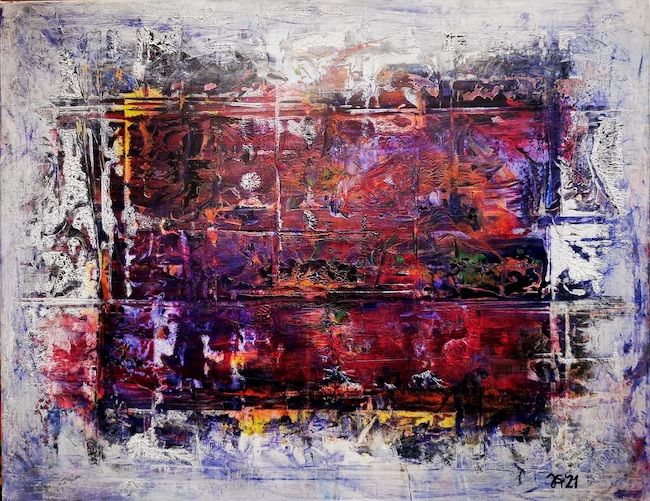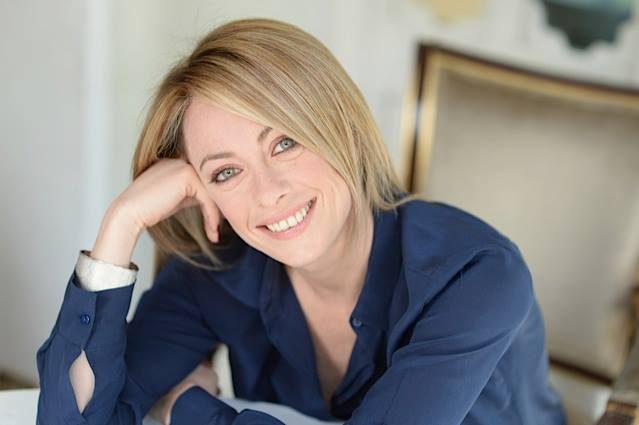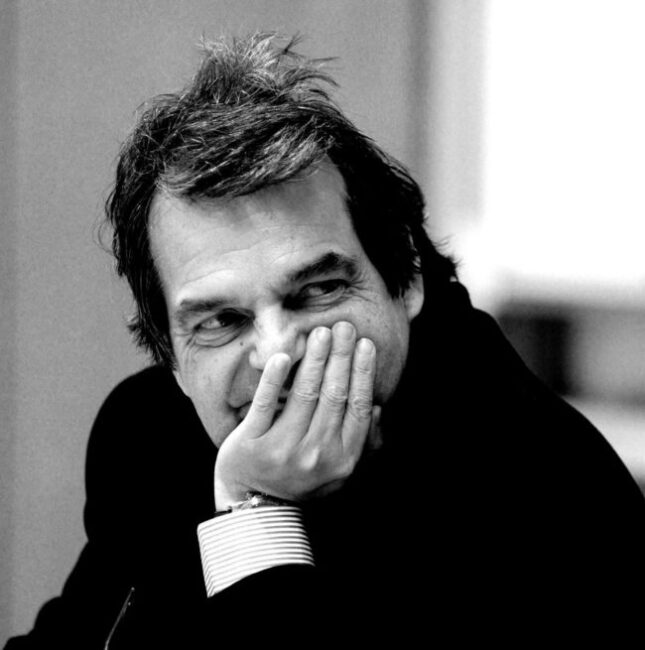Il passaggio dall’osservare tutto ciò che ruota intorno all’essere umano e il distaccarsene per dare la priorità a un mondo emotivo che spesso rifiuta ogni regola espressiva, si è cominciato a delineare nel secolo scorso ma è anche nell’arte contemporanea un punto focale, un’apparente linea di demarcazione tra quei creativi che hanno bisogno di aderire alla realtà per lasciar emergere le proprie sensazioni e quelli che, al contrario, necessitano addentrarsi nel mondo dell’indefinito per dar voce a tutto ciò che appartiene all’universo intimo e profondo del sentire e che non riuscirebbe a liberarsi se dovesse attenersi a regole e schemi. La protagonista di oggi genera un’armonica sintesi tra l’osservato e il percepito in cui solo avvicinandosi è possibile scorgere la mancanza di figurazione, dando vita a uno stile in grado di coinvolgere su più livelli l’osservatore delle sue opere.
Il momento in cui si delineò una nuova teoria stilistica in cui il gruppo di artisti che l’aveva concepita puntò a mettere in primo piano il mondo emozionale, il sentire più profondo a discapito della perfezione di una forma che non era più affine al cambiamento dei tempi in cominciava a emergere la centralità dell’individuo con tutte le sue debolezze, passioni, paure e gioie, la necessità di distaccarsi dalla realtà osservata divenne non solo funzionale a raggiungere l’obiettivo di sottolineare e far emergere le sensazioni dell’esecutore dell’opera, ma anche essenziale per creare quel distacco con un’arte accademica che nei secoli precedenti si era concentrata solo sull’apparire, sulla perfezione della forma, sulla riproduzione fedele dei soggetti che però nulla lasciava a tutta l’interiorità che poteva coinvolgere in maniera più intensa il fruitore della tela. I Fauves, questo il nome che si diedero quegli avanguardisti della libertà del mondo emotivo, non furono mai un vero e proprio movimento eppure lasciarono un profondo segno e una larga spaccatura con tutta l’arte accademica, gettando le basi per la nascita del successivo e più strutturato Espressionismo. La gamma cromatica irreale, il distacco dalla prospettiva, dal chiaroscuro, dalle sfumature per dare priorità a colori piatti e pieni, completamente lontani dall’osservato ma pienamente affini alle tempeste interiori, i contorni delle persone e degli oggetti e l’essenzialità delle forme contraddistinsero quello stile che però non riusciva a prescindere dall’immagine, da una figurazione che seppur traslata, trasformata, adeguata al nuovo intento pittorico, in ogni caso permaneva protagonista. Fu solo molti anni dopo, con il coraggio creativo di Jackson Pollock, Mark Rothko, Franz Kline, Arshile Gorky a cui poi si aggiunsero molti altri grandi artisti, che venne creato l’Espressionismo Astratto in cui, pur mantenendo la ribellione espressiva cominciata dagli espressionisti, divenne fondamentale distaccarsi dalla forma esteriore, dal contatto con la realtà, per entrare nel caos dell’indefinito, di quel fluire a volte veloce e concitato altre più lento e meditativo, più affine al mondo emozionale, a quell’incontrollabile vortice che ruota nell’interiorità e che non vuole schemi o regole per manifestarsi all’esterno. La libertà del gruppo si estese così anche allo stile attraverso cui compiere il processo di esternazione del proprio sentire, per cui non importava se si adottassero i concitati e impulsivi Dripping e Action Painting oppure il suggestivo Color Field, il variopinto e sorridente Tachisme o ancora l’espressione segnica, ciò che contava era la necessità di comunicare tutto ciò che era all’interno del proprio sé.
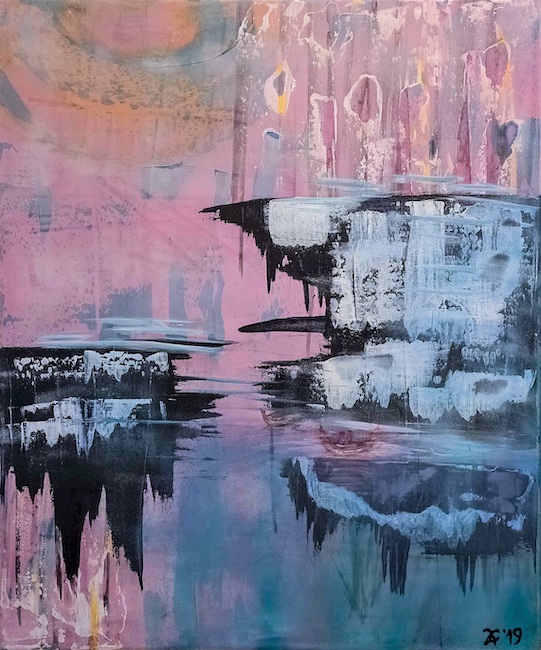
L’artista tedesca Katharina Andrée compie una sintesi, una fusione equilibrata tra la necessità di mantenere un legame apparente con la figurazione, con quei riferimenti visivi indispensabili come punto di partenza evidenziabile solo a distanza, per prendere per mano l’osservatore e condurlo solo in un secondo momento dentro quel mondo emotivo verso cui lei desidera scendere.
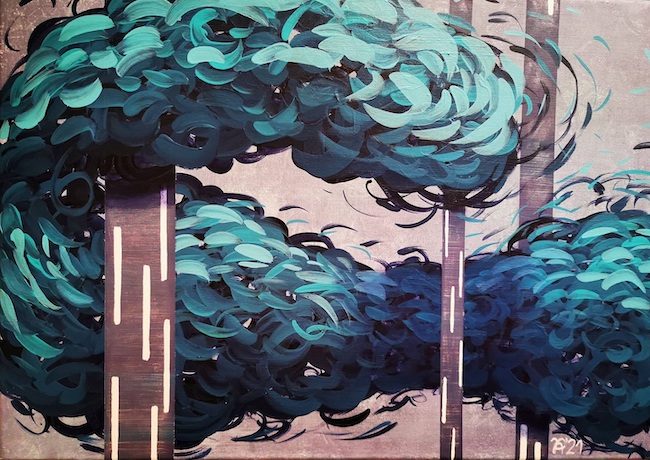
Il suo approccio è meditativo, riflessivo nei confronti di quelle tematiche esistenziali che l’uomo contemporaneo tralascia, quella capacità di ascoltare tutto ciò che si nasconde oltre la superficie e su cui raramente ci si interroga perché in fondo ciò che conta è correre verso gli obiettivi da raggiungere; la Andrée invece sembra invitare il fruitore a mettersi seduto alla maniera orientale e osservare l’invisibile, il silenzioso, quelle forze sottili e nascoste che, sulla lunga distanza, dominano il susseguirsi degli eventi, dei periodi, affascinando da sempre i grandi pensatori e i grandi filosofi che mai sono riusciti a dare una spiegazione della fuggevolezza di quei significati se non arrendendosi a essa.
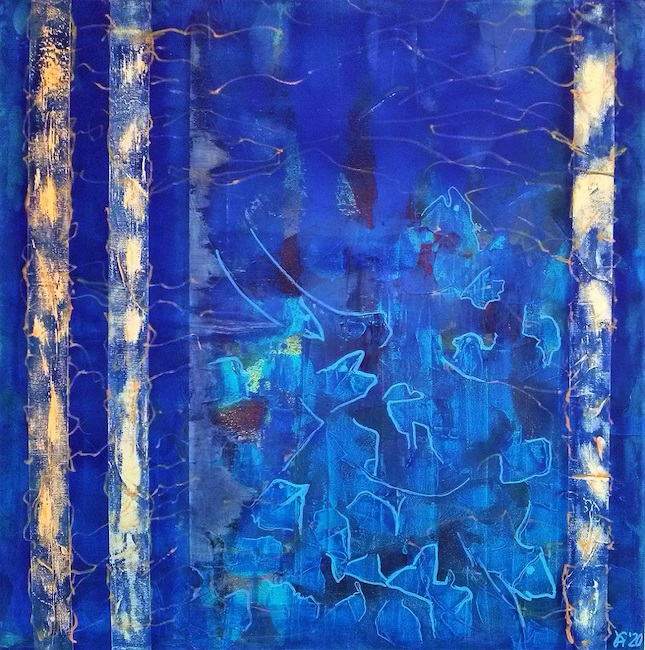
Lo scorrere, il fluire eracliteo, ripreso secoli dopo dal fisico e chimico Lavoisier che ne ha fatto il principio della sua ricerca scientifica, è di fatto ciò che domina il mondo conosciuto e quello che l’uomo ha sempre tentato di conoscere pur non riuscendoci; sono questi i temi su cui si concentra la ricerca pittorica di Katharina Andrée che si lascia andare alla suggestione del silenzio in virtù del quale poter riflettere su se stessa, sui grandi temi dell’umanità ma anche sui meccanismi difensivi dell’uomo moderno, quelle barriere dietro cui preferisce schermarsi per proteggersi impedendosi però, al contempo, di mostrarsi nella sua naturalezza.
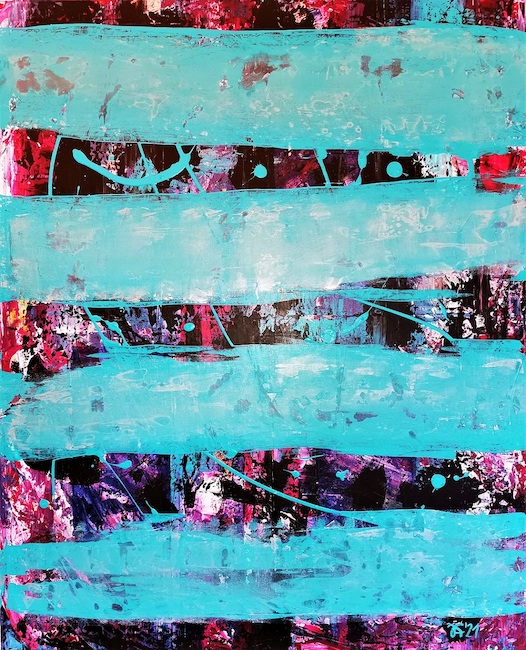
È questo il tema principale dell’opera Facciata in cui le larghe strisce orizzontali costituiscono ciò che viene mostrato all’esterno, l’apparenza ingannevolmente perfetta che si vuole dare, come il colore vivace turchese che la definisce, e che in realtà nasconde ben altro, un movimento retrostante fatto di ombre, narrate utilizzando il nero, e di emozioni sottintese che non devono fuoriuscire perché pericolose per l’autotutela che ci si impone di adottare.
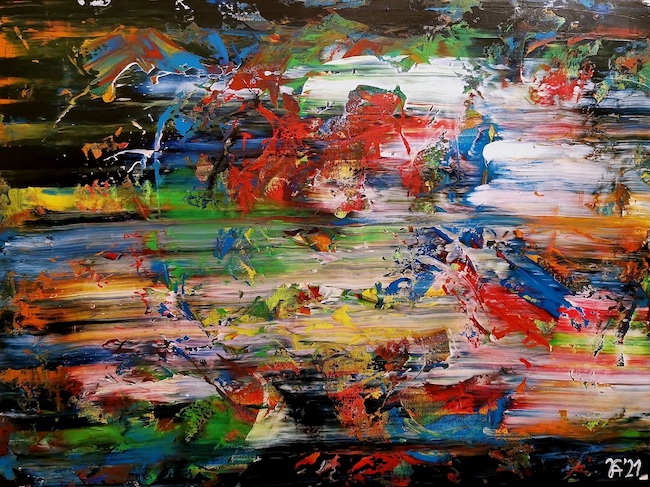
Nella tela Movimento eterno pone l’accento su quel Panta rei di Eraclito, quel continuo scorrere di accadimenti, di emozioni, di eventi attraverso i quali si compie quella trasformazione naturale dell’essere umano che è in grado di comprendere quanto sia fondamentale lasciarsi andare al fluire delle cose, al naturale susseguirsi di tutto ciò che deve far parte dell’esistenza del singolo per indurlo ad affrontare con maggiore apertura la sua vita tanto quanto la consapevolezza dell’impossibilità di opporsi alle forze esterne apprendendo dunque l’elasticità più morbida dell’adeguarsi al cambiamento. Dunque la gamma cromatica è vivace, caleidoscopica, proprio per mettere in luce le infinite possibilità che si dispiegano nel momento esatto in cui si prende atto della scorrevolezza, della modificazione costante a cui tutto è sottoposto e che non provoca disagio in chi la sa accogliere, tutt’altro, diventa meravigliosa risorsa.
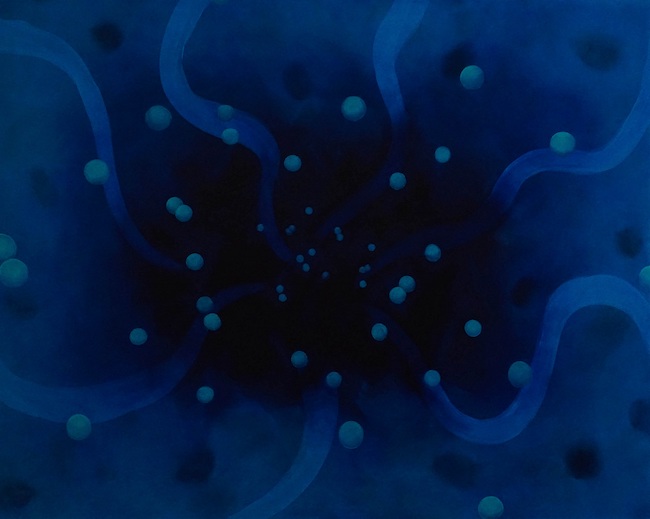
Con l’opera Infinito Katharina Andrée tenta di dare una spiegazione a tutto ciò che dalla notte dei tempi è rimasto sempre inspiegabile, inconoscibile, malgrado la volontà dell’essere umano di qualsiasi epoca di trovare il modo di scoprirne il mistero, di studiarne le caratteristiche che, proprio in virtù della sua non finitezza non possono essere delineate; così ne esplora la bellezza, l’oscurità che lo contraddistingue senza volerlo comprendere bensì dandone un punto di vista immersivo in cui accoglie l’incapacità di dare un senso a tutto e dove l’unica possibilità è lasciarsi trasportare dal suo fascino che può solo essere osservato e ammirato. Le tonalità in scala di blu contribuiscono a infondere nell’osservatore quell’ammaliante sensazione di potersi perdere in quel dolce arcano evocato dall’artista e che, proprio in virtù di un approccio positivo e consapevole, non fa paura, al contrario diviene invito ad addentrarsi nelle sue profondità pur sapendo che non potranno essere mai esplorate. Il silenzio della riflessione, una filosofia artistica orientata all’introspezione e all’ascolto, la capacità di interpretare le cose attraverso l’equilibrio dell’accettazione senza resistere ostinatamente agli eventi e alle energie che ruotano intorno all’individuo costituiscono la base pittorica di Katharina Andrée che si avvale di una tavolozza cromatica ampia, sulla base dell’emozione che ha bisogno di narrare, così come di una tecnica a volte più immediata come il Dripping, altre invece più meditata come quando inserisce brevi frammenti di pennellate per dare una visione globale osservabile solo dall’esterno, alla maniera degli impressionisti.

Katharina Andrée ha all’attivo la partecipazione a molte mostre collettive in Italia, in Corea, in Austria, oltre ovviamente nella sua Germania, dove ha ricevuto apprezzamenti dal pubblico e dagli esperti del settore.
KATHARINA ANDRÉE-CONTATTI
Email: katharina@andree01.de
Sito web: https://katharinaandree.de/
Facebook: https://www.facebook.com/katharina.andree.10
Instagram: https://www.instagram.com/katharinaartist/
The mysticism of the perpetual flow of existence in Expressionism between figuration and abstraction by Katharina Andrée
The transition from observing everything that revolves around the human being to detaching oneself from it in order to give priority to an emotional world that often refuses all expressive rules began to take shape in the last century but is also a focal point in contemporary art, an apparent dividing line between those creatives who need to adhere to reality in order to let their feelings emerge and those who, on the contrary, need to delve into the world of the indefinite in order to give voice to everything that belongs to the intimate and profound universe of feeling and that would not be able to free itself if it had to abide by rules and schemes. Today’s protagonist generates a harmonious synthesis between the observed and the perceived in which only by approaching it is possible to discern the lack of figuration, giving rise to a style capable of involving the observer of her artworks on several levels.
The moment in which emerged a new stylistic theory in which the group of artists who had conceived it aimed to bring the emotional world to the forefront, the deepest feelings to the detriment of the perfection of a form that was no longer in tune with the changing times in which the centrality of the individual with all his weaknesses, passions, fears and joys began to emerge, the need to detach oneself from the observed reality became not only functional to achieve the objective of underlining and bringing out the feelings of the artist, but also essential to create that detachment from an academic art that in previous centuries had focused only on appearance, on the perfection of form, on the faithful reproduction of subjects that, however, left nothing to all the interiority that could involve the user of the canvas in a more intense way. The Fauves, the name given to those avant-gardists of the freedom of the emotional world, were never a real movement and yet they left a deep mark and a wide rift with all academic art, laying the foundations for the birth of the later and more structured Expressionism. The unreal chromatic range, the detachment from perspective, from chiaroscuro, from shading to give priority to flat, solid colours, completely distant from the observed but fully akin to inner storms, the contours of people and objects and the essentiality of forms distinguished that style which, however, could not manage to ignore the image, from a figuration which, although shifted, transformed, adapted to the new pictorial intent, in any case remained the protagonist. It was only many years later, with the creative courage of Jackson Pollock, Mark Rothko, Franz Kline and Arshile Gorky, who were later joined by many other great artists, that Abstract Expressionism was created, in which, while maintaining the expressive rebellion begun by the Expressionists, it became fundamental to detach oneself from external form, from contact with reality, in order to enter the chaos of the indefinite, of that flow that is sometimes fast and excited, other times slower and more meditative, more akin to the emotional world, to that uncontrollable vortex that rotates in the interiority and that does not want schemes or rules to manifest itself outside.
The group’s freedom thus extended also to the style through which the process of externalizing their feelings could be carried out, so that it did not matter whether they adopted the excited and impulsive Dripping and Action Painting or the evocative Color Field, the multicoloured and smiling Tachisme or even the sign expression, what mattered was the need to communicate everything that was within their own selves. The German artist Katharina Andrée achieves a synthesis, a balanced fusion between the need to maintain an apparent link with figuration, with those visual references that are indispensable as a starting point noticeable only from a distance, to take the observer by the hand and lead him only later into that emotional world towards which she wishes to descend. Her approach is meditative, reflective with regard to those existential themes that contemporary man neglects, that ability to listen to all that is hidden beyond the surface and about which we rarely question ourselves because, in the end, what counts is running towards the objectives to be achieved; Andrée, on the other hand, seems to invite the viewer to sit down in the oriental manner and observe the invisible, the silent, those subtle and hidden forces which, over the long haul, dominate the succession of events, of periods, always fascinating the great thinkers and philosophers who have never managed to give an explanation for the fleetingness of those meanings if not surrendering to it. The ebb, the Heraclitean flow, taken up centuries later by the physicist and chemist Lavoisier, who made it the principle of his scientific research, is in fact what dominates the known world and what man has always tried to know but failed to do so; these are the themes on which Katharina Andrée’s pictorial research concentrates. She lets herself go with the suggestion of silence in virtue of which she can reflect on herself, on the great themes of humanity but also on the defensive mechanisms of modern man, those barriers behind which he prefers to shield himself to protect while at the same time preventing himself from showing his naturalness.
This is the main theme of the artwork Facciata (Facade) in which the wide horizontal stripes constitute what is shown on the outside, the deceptively perfect appearance that is intended to be given, such as the bright turquoise colour that defines it, and which in reality conceals something quite different, a movement behind it made up of shadows, narrated using black, and of subtextual emotions that must not be allowed to escape because they are dangerous for the self-protection that we impose on ourselves. In the painting, Movimento eterno (Eternal Movement), she emphasises Heraclitus’ Panta rei, that continuous flow of happenings, emotions and events through which the natural transformation of the human being takes place, capable of understanding how fundamental it is to let oneself go to the flow of things, to the natural succession of everything that must be part of the individual’s existence in order to induce him to face his life with greater openness, as well as the awareness of the impossibility of opposing external forces, thus learning the softer elasticity of adapting to change. So the colour range is lively, kaleidoscopic, precisely to highlight the infinite possibilities that unfold at the exact moment in which one takes note of the fluidity, of the constant modification to which everything is subjected and which does not cause discomfort in those who know how to accept it, on the contrary, it becomes a marvellous resource. With her work Infinito (Infinity), Katharina Andrée attempts to give an explanation to everything that since the dawn of time has always remained inexplicable, unknowable, despite the desire of human beings of all ages to find a way of discovering its mystery, of studying its characteristics which, precisely because of its non-finiteness, cannot be delineated; thus she explores its beauty, its obscurity without wanting to understand it, but giving it an immersive point of view in which she accepts the inability to make sense of it all and where the only possibility is to let be carried away by its charm, which can only be observed and admired.
The blue tones help to instil in the observer that bewitching feeling of being able to lose oneself in that sweet arcane evoked by the artist and which, precisely by virtue of a positive and conscious approach, is not frightening, but on the contrary becomes an invitation to delve into its depths in the knowledge that they can never be explored. The silence of reflection, an artistic philosophy oriented towards introspection and listening, the ability to interpret things through the balance of acceptance without stubbornly resisting the events and energies that revolve around the individual constitute the pictorial basis of Katharina Andrée, who uses a broad colour palette based on the emotion she needs to narrate, as well as a technique that is sometimes more immediate, such as dripping, and sometimes more thoughtful, such as when she inserts short fragments of brushstrokes to give a global vision that can only be observed from the outside, in the manner of the Impressionists. Katharina Andrée has taken part in many group exhibitions in Italy, Korea and Austria, as well as in her native Germany, where she has received praise from the public and experts.


